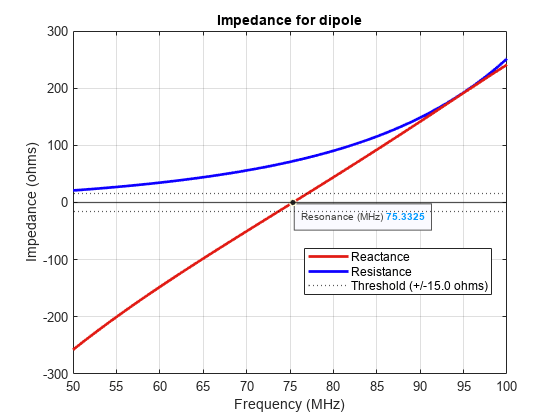resonantFrequency
Syntax
Description
resonantFrequency(
marks the resonant frequencies on the impedance plot of the specified antenna or array in
the specified frequency range. If no resonant frequency is detected in the specified
frequency range, this syntax plots the impedance of the specified antenna or array without
any marked points.object,frequency)
resonantFrequency(
marks the resonant frequencies on the S11 plot of the specified
antenna or array in the specified frequency range. If no resonant frequency is detected in
the specified frequency range, this syntax plots the S11 of the
specified antenna or array without any marked points.object,frequency,Method="Sparameters")
resonantFrequency(
marks the resonant frequencies on the impedance plot of the specified antenna or array in
the specified frequency range with additional options specified by one or more Name-Value Arguments. If no resonant
frequency is detected in the specified frequency range, this syntax plots the impedance of
the specified antenna or array without any marked points.object,frequency,Method="Impedance",Name=Value)
resonantFrequency(
marks the resonant frequencies on the S11 plot of the specified
antenna or array in the specified frequency range with additional options specified by one
or more Name-Value Arguments. If no resonant
frequency is detected in the specified frequency range, this syntax plots the
S11 of the specified antenna or array without any marked
points.object,frequency,Method="Sparameters",Name=Value)
fRES = resonantFrequency(
calculates and returns the resonant frequencies of the specified antenna or array in the
specified frequency range. object,frequency)fRES is empty if no resonant frequency is
detected in the specified frequency range. fRES is a vector when more
than one resonant frequencies are detected in the specified frequency range.
fRES = resonantFrequency(
calculates and returns the resonant frequencies of the specified antenna or array in the
specified frequency range using additional options specified by one or more Name-Value Arguments.
object,frequency,Name=Value)fRES is empty if no resonant frequency is detected in the specified
frequency range. fRES is a vector when more than one resonant
frequencies are detected in the specified frequency range.
[
calculates and returns the resonant frequencies fRES,zRES,Z,typRES] = resonantFrequency(object,frequency)fRES and the
corresponding impedances zRES and resonance type
typRES (series or parallel) for the specified antenna or array in the
specified frequency range. fRES, zRES, and
typRES are empty if no resonant frequency is detected within the
specified frequency range. fRES and zRES are
vectors, and typRES is a string array when more than one resonant
frequencies are detected. Z is a vector of all the impedance values
across the specified frequency range.
[
calculates and returns the resonant frequencies fRES,zRES,Z,typRES] = resonantFrequency(object,frequency,Method="Impedance",Name=Value)fRES and the
corresponding impedances zRES and resonance type
typRES (series or parallel) for the specified antenna or array in the
specified frequency range using additional options specified by one or more Name-Value Arguments.
fRES, zRES, and typRES are
empty if no resonant frequency is detected within the specified frequency range.
fRES and zRES are vectors, and
typRES is a string array when there are more than one resonant
frequencies. Z is a vector of all the impedance values across the
specified frequency range.
[
calculates and returns the resonant frequencies fRES,sRES,S] = resonantFrequency(object,frequency,Method="Sparameters")fRES and the
corresponding S11 values sRES for the specified
antenna or array in the specified frequency range. fRES and
sRES are empty if no resonant frequency is detected within the
specified frequency range. fRES and sRES are vectors
when more than one resonant frequencies are detected. S is a vector of
all the S11 values across the specified frequency range.
[
calculates and returns the resonant frequencies fRES,sRES,S] = resonantFrequency(object,frequency,Method="Sparameters",Name=Value)fRES and the
corresponding S11 values sRES for the specified
antenna or array in the specified frequency range using additional options specified by
one or more Name-Value Arguments. S
is a vector of all the S11 values across the specified frequency
range.
Examples
Input Arguments
Name-Value Arguments
Output Arguments
Version History
Introduced in R2024a

